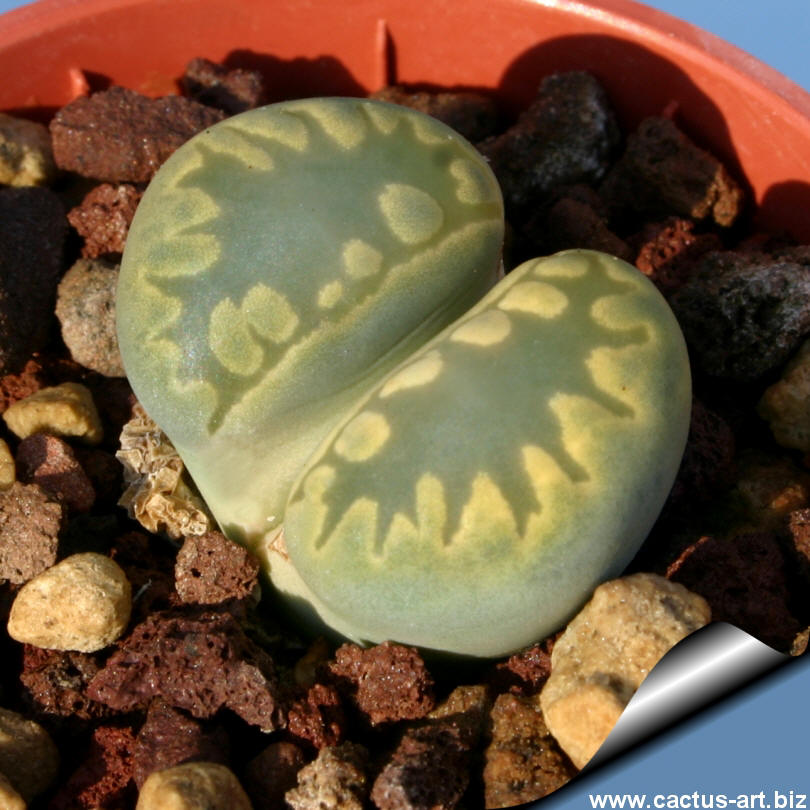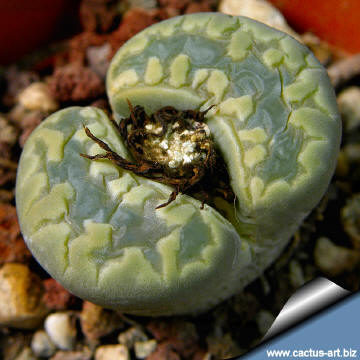|
|
|

Lithops otzeniana C128A cv. AQUAMARINE - 35 km NNW of
Loeriesfontein, South Africa
|
|
Description: Lithops otzeniana
usually forms small groups with 2-5 heads but occasionally with up to 25
heads (especially in cultivation). It is a very peculiar species easily
distinguished for its translucent greenish-olive top with lighter
raised, scalloped islands around the edges.
Cole numbers: C128, C280, C350
Body (paired leaves): Up to 3 cm hight and 20-30 mm x 15-20 mm
wide, cordate truncate in profile, with a relative deep fissure and
lobes half-moon shaped more or less divergent,
Face: More or less elliptical smooth to moderately rugose and
more or less convex.
Margin: Very distinct with elevated teeth-like rounded
peninsulas.
Island: Usually few but sometime numerous mostly included among
the margins peninsulas. Colour light grey with shades of pink, cream,
green or blue.
Windows: Mostly occluded with broad to narrow channel. Colour:
Greenyish, olive-green or bluish green, translucent sometime with white
or pink shadows.
Rubrication: Not present.
Flowers: Yellow with a white throat, about 1,5-3,5 cm diameter.
Blooming season: Early autumn.
Fruit: Mostly 5-loculed capsules.
Cultivars:
-
Lithops otzeniana cv. Aquamarine'1985
Cole number: C128A
This cultivar comes from a unique specimen collected by Collected by
D.T. & N.A. Cole. Its peculiarity are the dark greyish-green windows
with pale creamy-green margin, indentation and island. Apart for the
colour the plant is identical to the standard form. Origin: North West
of Loeriesfontein.
-
Lithops otzeniana cv. Cesky Granat 2001
Similar in shape and size to the normal form but with a distinctive
red colouring.
|

Lithops otzeniana C128A cv. AQUAMARINE |

Lithops otzeniana C128A cv. AQUAMARINE |
|
Advertising
|
|
|
|
Family: Mesebrianthemaceae (Aizoaceae)
Scientific name: Lithops
otzeniana lG.C. Nel
In: Kakteenkunde 123-127, 1937
Origin: South Africa,
Northern Cape, (Bushmanland) district Calvinia
TL 'Bushmanland: Brakfontein, 30 miles from Loeriesfontein
Habitat:
Endemic
to a very small area. The substrate comprises mainly gneiss and granite
rocks. The plants grows ether on open places and under bushes.
Background colours: Grey-white, pale brown or greenish.
Common English Names include: Stone plant, Living
stone.
Etymology:
Named after M.
Otzen who accompanied Nel in the exploration trip
during which it found this species.
Remarks: Lithops are partly
subterranean, with only the clear 'window'
in each leaf tip exposed above soil. A type of optical system exists
whereby a layer of apical tissue rich in calcium oxalate crystals acts
as a filter to intense sunlight before it reaches the thin
chlorophyllous layer below. They are also called
mimicry plants as they show a striking similarity to their
background rocks and are difficult to detect when not in flower. These
are the commonly known as pebble plants or living stones; each species
is associated with one particular type of rock formation and occurs
nowhere else. Its soil-embedded, subterranean growth form also reduces
the need for chemical defences against herbivores.
|
|
|
|
Cultivation:
Need an open mineral, fast draining mix and the maximum amount of light
you are able to give them. The basic cultivation routine is: Stop
watering after flowering. Start watering after the old leaves completely
dry. (Usually late March or Early April) Water freely during the growing
season, soak the compost fully but allow it to dry out between waterings,
no water when cold. Some growers fertilize
frequently, some hardly ever. Keep them dry during the winter. Nearly
all problems occur as a result of
overwatering and poor ventilation especially when weather
conditions are dull and cool or very humid. This plant is best
for a well lit area (Bright
shade to
full sun). But don't be afraid even
the best growers have plants that mysteriously dry up, or leave during
the night.
Note: After flowering in the
autumn and extending through
winter
season the plant doesn’t need
watering, but they will still be
growing, the new
bodies will be increasing in size extracting
water from the outer
succulent leaves, allowing them to
shrivel away. In fact the plant in this time extracts
water and
nutrient stored in the outer
succulent leaves, allowing them to
dehydrate relocating the water to the rest of the plant and to
the new leaves that form during this period until the old leaves are
reduced to nothing more than "thin papery shells".
Photo of conspecific taxa, varieties, forms and cultivars of
Lithops otzeniana.


|
|